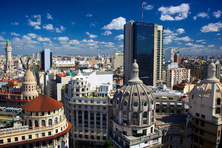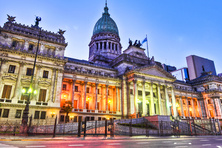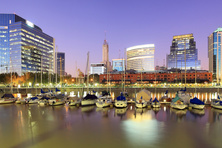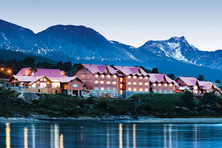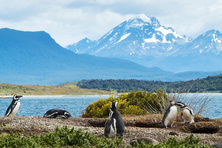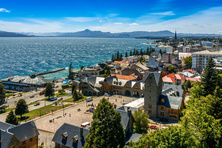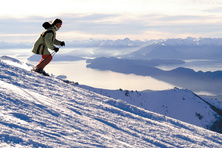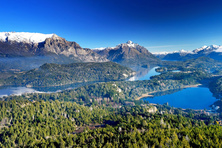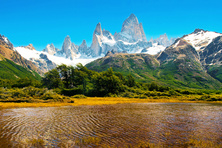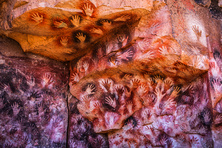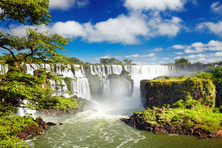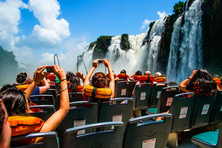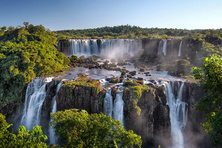Argentina
- Currency: Argentine peso
- Time: UTC-3
- Languages: Spanish
- Religions: Christianity (Catholicism, Protestantism)
- Sections: Get in Visa Customs Cuisine Money Details of interest Popular resorts
Argentina or officially the Argentine Republic is a state in the South America. It borders Chile, Bolivia, Paraguay, Brazil and Uruguay. Its southeastern part is washed by the waters of the Atlantic Ocean. The capital of the country is Buenos Aires.
The climate in Argentina is predominantly subtropical with the tropical climate in the north and temperate continental in the south. The best time for visiting Argentina is from November to March.
The official language is Spanish. The predominant religion is Catholicism and about 10% of the population are the Protestants.
The foreigners come to Argentina for sandy beaches, picturesque parks and historical heritage of the country.
While in Argentina there are not so many ancient monuments as in the Old World, this country is of great interest for the tourists. In such cities as Buenos Aires, Cafayate, Cordoba, Mendoza, Posadas, San Martin, San Pedro, Salta, and Formosa, the tourists can learn about the colonial history of the country.
On the vast territory of Argentina, you can find various types of a landscape from sandy deserts in Patagonia to tropical Chaco forests, mountains and vast swamplands. Ushuaia and El Calafate and such provinces as Jujuy, Misiones, Catamarca, San Luis, Tucuman, Chubut and Entre Rios are popular destinations for the ecotourism.
For beach holidays go to the Atlantic coast. You will find the best beaches in Mar del Plata and the lovers of windsurfing usually come to Puerto Madryn.
In the Andes, there are some ski resorts. The tourists like to ski in the Province of Rio Negro San Carlos de Bariloche and San Juan.
Get in
By Plane
CIS countries do not have direct flights to Argentina, so the tourists can get to the country through Europe. There are direct flights from Paris, Frankfurt, London, Madrid, and Rome.
By Land
While traveling in the South America, you can get to Argentina by bus or by car from the territory of all the neighboring countries. Argentina does not have an international railway communication.
By Ferry
There is a ferry route between Buenos Aires and Uruguay through the Rio de la Plata.
Visa
The tourists from the European Union, Russia, Ukraine and Armenia can travel to Argentina for 90 days without a visa. The same rule applies to the citizens of Kazakhstan but they can stay in Argentina without a visa for 30 days. The travelers from other CIS countries have to obtain a visa to come to Argentina.
You can apply the documents for a visa personally or through an authorized person. Usually, it takes three of five working days to get the visa.
Customs
Customs legislation of Argentina does not restrict import and export of currency but the sum of 10.000 US dollars or its equivalent must be declared. Gold and golden jewelry also must be declared.
You can import into Argentina duty-free the following things:
- a small amount of alcohol and tobacco;
- not more than 5kg of canned goods;
- personal belongings (in a reasonable amount);
- souvenirs and gifts of a total sum not exceeding 300 US dollars.
It is prohibited to import into the country:
- any non-preserved foods;
- art objects and items having a historical value.
It is prohibited to export:
- Woolen and leather goods, jewelry and souvenirs (without the receipt);
- fur goods without the receipt or a special export label;
- art objects and items having a historical value.
Cuisine
The Argentine national cuisine is a combination of many culinary traditions of the local Indians, European settlers and the descendants of the African slaves. The hallmark of the Argentine cuisine is beef.
We recommend such meat Argentine dishes as Parrillada (a mix of several types of meat), Asado (grilled beef) and Carbonado (beef with fruits and vegetables).
Poultry is an ingredient for such dishes as Cazuela Gaucho (chicken with pumpkin), Suprema de pollo (crispy chicken) and Pollo a la sal (chicken boiled with salt).
The most popular Argentine soups are Locro (a thick soup with corn, beans and potatoes), Cazuela (a thick soup with vegetables and spices) and oxtail soup.
Having a long sea coastline, several large rivers and lakes, fish and seafood dishes could not but appear in the Argentine menu. The tourists will be offered Filet a la romana (fried fish with vegetables) and Calamar a la provenzal (squid boiled with herbs).
Vegetables are usually used for side-dishes. Among the most popular vegetable dishes and pastry are Faina (a pie with chickpea and olive oil), Zapallitos rellenos (stuffed marrow) and Ensalada de frutas (something between a soup and a fruit salad).
The Argentine desserts include famous Dulce de leche (thick creamy caramel sauce traditionally prepared with milk and sugar), Alfajor (a pie with Dulce de leche), Queso con dulce (cheese with fruit jelly) and Mazamorra (a corn dessert with milk, sugar and vanilla).
A traditional non-alcoholic drink in Argentina is the tea Mate. The Argentinians also like juices and other drinks with local herbs and fruits.
The Argentine wines can compete with Spanish and French wines and their only 'disadvantage' is that they are not so famous. The best wines are Malbec and Torrontes.
Money
The official currency is Argentine peso (ARS) which is equal to 100 centavos. The Central Bank of the Argentine Republic issues the banknotes from 1 to 100 pesos and coins from 1 centavo to 5 pesos.
In Argentina, you can exchange the currency at banks, in exchange offices, hotels and malls. You can pay with US dollars almost everywhere in the country.
Credit cards are accepted in the majority of shops, restaurants and hotels in large cities. In small cities, credit cards are almost never accepted.
The tourists can cash their traveler's checks at banks and in special exchange offices where the exchange rate is a bit better.
There are ATMs in large cities but to avoid too large commission we recommend using cards with the dollar account.
Argentina participates in the tax-free system and the tourists can refund the VAT (21%) if the total cost of their purchase is, at least, 70 peso. They can apply for the refund at the customs.
The travelers should be very attentive and careful in large cities because of a high level of street crimes. Poor districts are particularly dangerous but a province is a safe place for the tourists.
Details of interest
Sightseeing in Argentina
In Argentina, there are nine UNESCO sites which the tourists can visit:
- The Los Glaciares National Park is a mountain area of exceptional natural beauty. On its territory, there is the largest ice cap in Antarctica and Greenland.
- The Jesuit Missions of the Guaranis. These are the ruins of the five Jesuit missions built in the 17th — 18th centuries on the territory of the modern Argentina and Brazil.
- The Iguazu National Park is a cascade of almost 300 waterfalls on the Iguazu river. The park is surrounded by the tropical forest. This is a must-visit place in Argentina.
- Cueva de las Manos cave has a unique collection of cave drawings the age of which is from 9.500 to 13.000 years old. The cave became famous because the prints of human hands made several thousands of years ago were found there.
- Valdes Peninsula is a district which is critically important for preserving rare species of sea mammals (right whales, sea elephants and sea lions). This is also a very popular place for watching the whales.
- Natural parks Parque Provincial Ischigualasto and National Park Talampaya. These are two neighboring parks in a desert area of Argentina. These parks have a very picturesque landscape and the fossils of the prehistoric fauna and flora.
- Museo Estancia Jesuitica y casa del Virrey Liniers in Cordoba is a South American “headquarter” of the Jesuits in the 17th-18th centuries.
- Quebrada de Humahuaca is a picturesque valley which was one of the main trading routes in the earlier times.
- Andean Road System is the Argentine portion of the road system which the Indians were building over the hundreds of years.
Staying in Argentina, visit, at least, one of the UNESCO candidate sights. The most interesting are:
- Aventura Calchaqui;
- The national park Sierra de las Quijados;
- The national park Los Alerces.
You should not miss a chance and visit other sights in Argentina which are not included in the UNESCO World Heritage List but of a great touristic interest:
- Ibera Wetlands;
- National Monument to the Flag in the city of Rosario;
- Historical center in Santa Fe.
Argentine Souvenirs
In Argentina, the tourists usually buy:
- Mate tea and calebasse (mate tea bowl);
- Leather goods;
- Poncho;
- Argentine wines.







